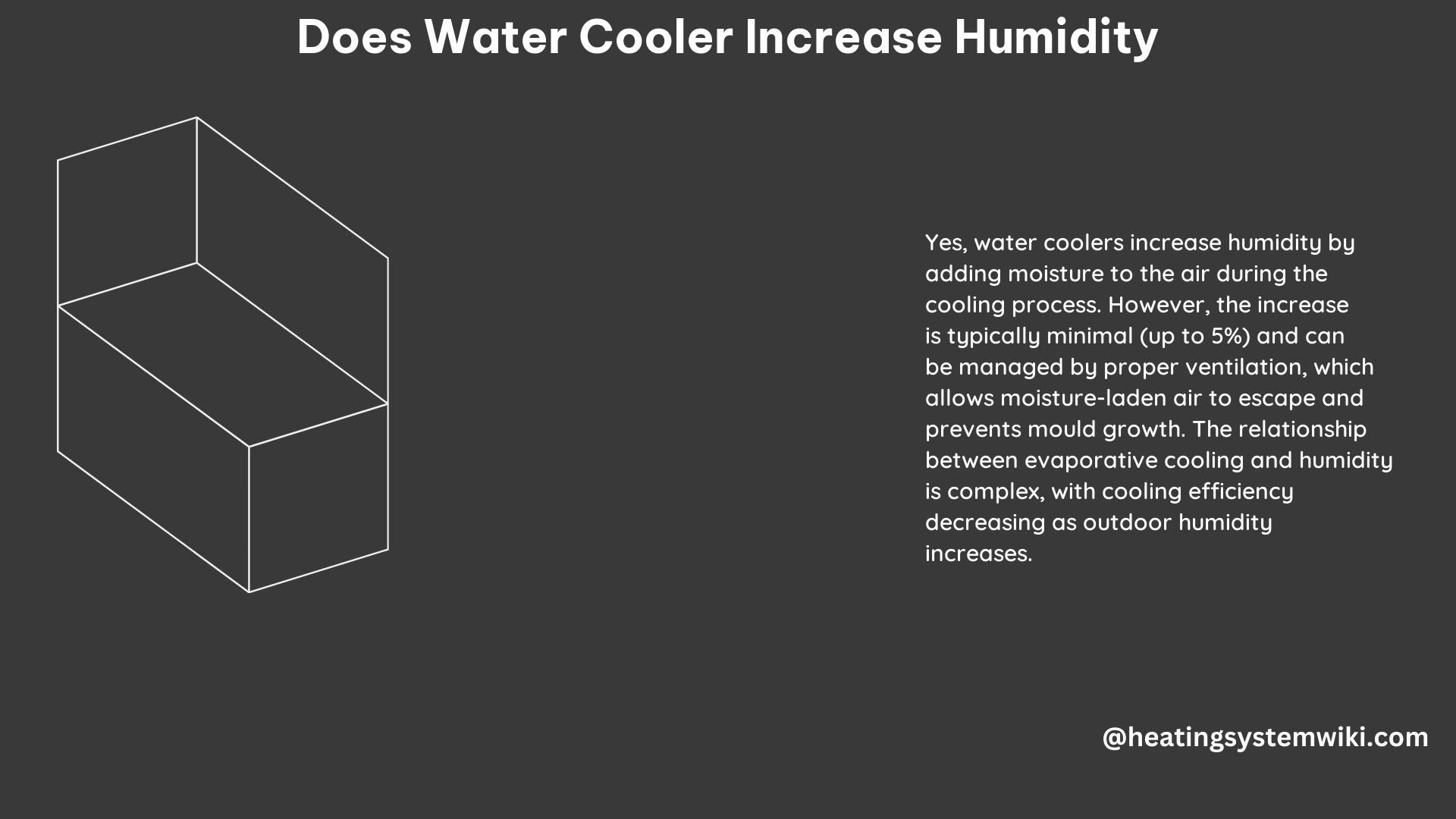Water coolers, particularly evaporative coolers, can increase the humidity levels in a room, but the degree of increase depends on various factors. This comprehensive technical guide will delve into the specifics of how water coolers impact humidity and provide DIY solutions to minimize the increase.
Technical Specification of Does Water Cooler Increase Humidity
Type of Water Cooler
The type of water cooler used can significantly impact the humidity levels in a room. Here’s a breakdown of the different types and their effects:
-
Evaporative Coolers: These coolers work by using the process of evaporation to cool the air. As water evaporates, it releases moisture into the air, leading to an increase in humidity levels. The degree of increase can range from 5% to 20%, depending on the specific design and efficiency of the evaporative cooler.
-
Refrigerative Coolers: Also known as air conditioners, these coolers use a refrigeration cycle to cool the air. They do not directly add moisture to the air, but they can indirectly affect humidity levels by removing moisture from the air during the cooling process. The resulting humidity levels can range from 30% to 60%, depending on the room’s temperature and ventilation.
-
Hybrid Coolers: These coolers combine evaporative and refrigerative technologies, offering a balance between cooling and humidity control. The increase in humidity levels can range from 2% to 10%, depending on the specific design and operating conditions.
Existing Humidity Levels
The existing humidity levels in the room can significantly impact the degree of increase caused by a water cooler. Here’s a breakdown of the relationship:
-
Low Humidity (10-30%): In low-humidity environments, evaporative coolers can provide a more significant cooling effect, with temperature drops of 20-30°F (11-17°C). However, the increase in humidity levels can be more noticeable, ranging from 10% to 20%.
-
Moderate Humidity (40-60%): In moderately humid environments, evaporative coolers can still provide a cooling effect, with temperature drops of 10-15°F (6-8°C). The increase in humidity levels is typically less pronounced, ranging from 5% to 10%.
-
High Humidity (70-90%): In highly humid environments, evaporative coolers become less effective, with temperature drops of only 5-10°F (3-6°C). The increase in humidity levels is also less significant, typically ranging from 2% to 5%.
Temperature and Ventilation
The temperature and ventilation in the room can also affect the impact of a water cooler on humidity levels. Here’s how:
-
Temperature: Higher temperatures can increase the evaporation rate, leading to a more significant increase in humidity levels. Conversely, lower temperatures can slow down the evaporation process, resulting in a smaller increase in humidity.
-
Ventilation: Proper ventilation is crucial for minimizing the increase in humidity levels. By allowing the moisture-laden air to escape and be replaced with cooled air, ventilation can help maintain a comfortable indoor climate.
Type of Evaporative Cooling System
The specific design and technology of the evaporative cooling system can also impact the degree of humidity increase. For example, Oxycom’s patented indirect/direct evaporative cooling technology can ensure up to 70% less increase in humidity compared to other direct evaporative cooling systems.
Does Water Cooler Increase Humidity DIY

To minimize the increase in humidity caused by a water cooler, you can take the following DIY steps:
- Ensure Proper Ventilation:
- Open doors and windows during the cooler’s operation to allow the moisture-laden air to escape and be replaced with cooled air.
- Install exhaust fans or use ceiling fans to improve air circulation and ventilation.
-
Adjust the airflow and direction of the water cooler to optimize the air exchange in the room.
-
Monitor Humidity Levels:
- Use a hygrometer to regularly monitor the humidity levels in the room.
- Aim to maintain humidity levels between 30% and 50% for optimal comfort and to minimize the impact of the water cooler.
-
Adjust the ventilation and airflow accordingly based on the observed humidity levels.
-
Choose the Right Type of Cooler:
- Consider the existing humidity levels and temperature in the room when selecting a water cooler.
- In humid climates or poorly ventilated rooms, evaporative coolers may not be the best option, and you may want to consider a refrigerative or hybrid cooler instead.
-
Look for water coolers with advanced technologies, such as Oxycom’s indirect/direct evaporative cooling system, to minimize the increase in humidity.
-
Maintain the Cooler:
- Regularly clean and replace the cooler pads to ensure optimal performance and efficiency.
- Check for any leaks or water buildup that could contribute to increased humidity levels.
- Follow the manufacturer’s recommendations for maintenance and upkeep to maintain the cooler’s effectiveness and minimize its impact on humidity.
By understanding the technical specifications and implementing these DIY solutions, you can effectively manage the impact of a water cooler on the humidity levels in your space, ensuring a comfortable and energy-efficient indoor climate.
